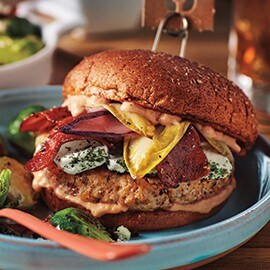Burgers are perennial favorites that can be adapted to appeal to just about everyone. So how do you grow a category with such mass appreciation? Incorporating global flavours is a good way to appeal to the 42% of women and 38% of men aged 18-34 who are interested in burgers with internationally inspired toppings.1

Let’s take a trip through different areas of the world and highlight the flavours that can help you take your burgers to the next level.
AFRICA
The spices that come to mind when thinking of Africa (cumin, cardamom, and ginger) can add new dimension to your burgers, but you should also consider some of the patty variations inspired by the continent.

Tagine Burger
Sweet and savory flavours come together in typical tagine dishes, and that combo goes especially well with a spiced lamb patty tagine burger. Consider a fig spread for an unexpected topping guests will appreciate.
Boerewors Burger
Boerewors is a traditional South African sausage made with a blend of beef and pork along with spices such as toasted coriander seed, black pepper, nutmeg, cloves and allspice. It also makes an amazing burger patty. Go with a milder cheese so the spices really come through. A creamier cheese spread like pimento cheese is also a good way to bring in that element guests are accustomed to.
MIDDLE EAST
This region is especially suited for crafting dishes that cater to guests looking for items with a healthy halo.

Bun Options
Guests are open to seeing other types of breads for their burgers. In fact, 47% of consumers are interested in seeing premium buns for burgers at restaurants.2 Naan makes for a delicious alternative. It brings a new texture and flavour to the equation that complements lamb or chickpea patties.

Harissa Gains Wider Appeal
Menu mentions of this middle eastern spice are up. You can stir it into an aioli or ketchup for a new condiment for burgers and fries alike. The earthy spiciness is a welcome addition to grilled burgers and the unique flavour of lamb.
INDIGENOUS AMERICA
There’s a growing movement of guests looking for dishes that harken back to frontier times and Native staples.
Bison Burgers
These patties are an appealing alternative to beef because of their similar taste and texture, but they’re leaner and bring some uniqueness to your menu. Bison is often grass fed which is something consumers like to see. Be sure to call that out if it’s applicable. The meat comes at a premium so make sure to adjust pricing accordingly. To make a more expensive burger option more alluring to guests, use menu callouts to let diners know about the farm where the bison was raised or benefits of bison meat.


Meatless with Identifiable Ingredients
Meat-free and veggie burgers have gotten a makeover in recent years using different beans as a base. While black beans are the preferred base for vegetarian burgers, others are being made with cranberries, amaranth, corn, other beans and potatoes.
For example, the Guac Burger at “by CHOLE“ in New York is made with black beans, quinoa and sweet potatoes. In 2015, Gothamist named it the best veggie burger in the city. UFS chef Dana Cohen says, “I think it's also important to create meatless burgers that still maintain that ‘meaty’ texture, so vegetarians and meat eaters can enjoy alike.”
LATIN AMERICA
The flavours of Latin America are perfect for layering onto traditional burgers. Adding spice along with creamy elements like guacamole and cojita cheese creates a more complex offering. Sides such as yucca fries help complete the experience.
Double Up on Protein
These patties are an appealing alternative to beef because of their similar taste and texture, but they’re leaner and bring some uniqueness to your menu. Bison is often grass fed which is something consumers like to see. Be sure to call that out if it’s applicable. The meat comes at a premium so make sure to adjust pricing accordingly. To make a more expensive burger option more alluring to guests, use menu callouts to let diners know about the farm where the bison was raised or benefits of bison meat.


Guac Isn’t Extra
Guacamole has seen a 7.6% menu growth over the last 5 years, with burgers as one of the fastest growing dishes to feature this popular item.4 Whether house-made or prepackaged, guacamole is a standard topping option that gives diners one more way to customize their burger experience.
On the subject of toppings and burger customization, it’s worth noting items like sauteed mushrooms and onions are being replaced by more fun and upscale choices such as fried duck eggs, fried pickles, kimchi, and other pickled vegetables like jalapeños.
ASIA
Asian fusion has already taken hold in other menu categories, and burgers are poised to be the next to be enhanced by the flavours of this diverse region.

Sauce and Marinade
Classic, staple sauces can be used as condiments or to flavour the meat itself. Gochujang, soy sauce, hoisin, cabbage slaw, and Korean BBQ seasoning all complement beef patties very well. The Seoul Burger at Holy Cow del Ray in Alexandria, Virginia, has angus beef, smoked pork belly, kimchi and gochujang sauce on a toasted brioche bun.
Attention to Quality Beef
There’s always a set of customers looking for premium upgrades, and nothing says premium quite like Wagyu beef. Burgers made with this variety of meat may not fly out of the kitchen, but consider bringing them on as an LTO to see how your customers respond before adding them to your permanent menu. There’s also the opportunity to create an ultra-premium offering using other high-end ingredients like artisan cheeses, upscale cuts of meat, or unique produce.

Burgers have long been the foundation on which you can showcase your creativity and passion for innovative ingredients and toppings. Taking cues from around the globe can help you further set yourself apart from competitors and create a loyal following. Here’s to a more adventurous burger menu.
1 Mintel’s Innovation on the Menu – US, October 2015 (guests aged 18-34)
2 Mintel, The State of the Burger April 2016
3 Technomic, Menu Search 2016 Q2-2017 Q2
4 Technomic, Guacamole Q1 2017
5 Technomic, Burger Consumer Trend Report June 2017


